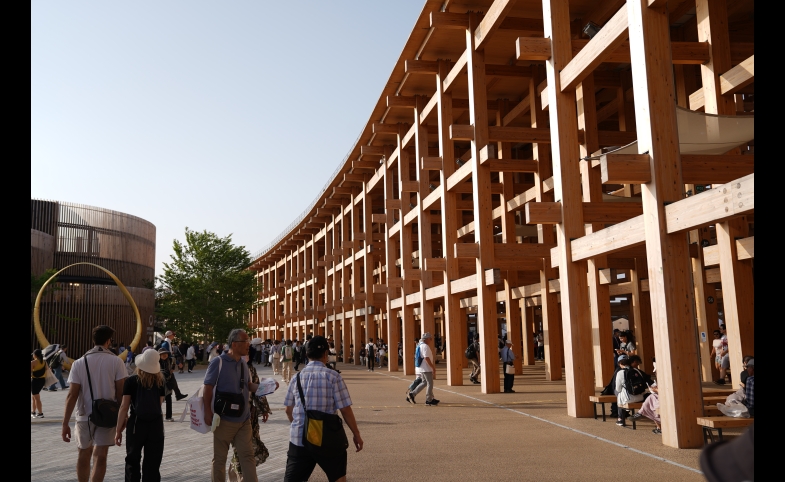This article is part of the CPD Blog series, “Expo 2025 Viewpoints,” featuring essays and photographs by USC Master of Public Diplomacy students who toured the Expo in Osaka, Japan.
KEEP READINGThe CPD Blog is intended to stimulate dialog among scholars and practitioners from around the world in the public diplomacy sphere. The opinions represented here are the authors' own and do not necessarily reflect CPD's views. For blogger guidelines, click here.

Expo 2025 Viewpoints: Reimagining International Media Engagement at World Expos
This article is part of the CPD Blog series, “Expo 2025 Viewpoints,” featuring essays and photographs by USC Master of Public Diplomacy students who toured the Expo in Osaka, Japan.
I had never been to a World Expo. I had researched it. I had read about it. I had received multiple briefings from Professor Jay Wang, a leading scholar on World Expositions and Public Diplomacy. Still, nothing prepared me for what my six days in Osaka would feel like.
The World Expo—or World’s Fair, as it’s historically known—is arguably the largest and most dynamic public diplomacy event in the world. And yet, it only takes place once every five years.
This year, Japan hosted for the third time—previously in Osaka (1970), then Aichi (2005), and now again in 2025 on Yumeshima Island in Osaka. The theme: “Designing Future Society for Our Lives”—with three sub-themes: Saving Lives, Empowering Lives, and Connecting Lives. Each pavilion offered a distinct vision of the future. And while global mega-events often come with logistical hurdles, I left Osaka invigorated by the possibilities of what diplomacy, storytelling, and cultural exchange can achieve together.
The Power of National Presence
Australia
Australia focuses on presenting a modern and diverse national identity—highlighting First Nations stories, gender equality, and regional cooperation. Their task force within DFAT worked closely with Japanese partners to align public diplomacy efforts with long-term bilateral goals. The Australia Pavilion at Expo 2025 Osaka is themed "Chasing the Sun" and showcases Australia's natural beauty, cultural richness, and innovative spirit through a multisensory journey.
Cameroon
Cameroon brings vibrant cultural performances and showcases its artistic and creative economy as part of Africa’s emerging voice in global forums. The Cameroon Pavilion's theme is "An Emerging Cameroon united in its diversity" and is located in the Saving Lives zone of the Expo grounds.
Canada
Canada emphasizes authenticity and inclusion, showcasing Indigenous perspectives, gender equity, and sustainability through culinary diplomacy, identity visibility, and youth-led performances. The Canada Pavilion, themed "Regeneration," features an exterior inspired by thawing rivers and an interior full of interactive, immersive experiences.
France
France designed an enigmatic pavilion built around the theme of “Love”—exploring national identity through culture, innovation, and symbolism while cleverly navigating luxury and historical expectations. Its design draws on the Japanese red thread legend and is described as a "theater of life."
Japan
The Japan Pavilion at Expo 2025 in Osaka, Kansai, serves as a central symbol for the Expo theme. Conceptualized as "Between Lives," the pavilion explores interconnectedness and cyclical systems. It showcases technologies in carbon recycling, biogas production, and sustainability-driven innovation.
Nigeria
Nigeria, a leading voice in the African Continental Free Trade Area (AfCFTA), is using the Expo to reframe Africa’s narrative through innovation, culture, and economic potential—featuring textiles, music, raw materials, national icons, and culinary heritage. The Nigeria Pavilion showcases "Made-in-Nigeria" tech and services, including Fintech and renewable energy.
Qatar
Qatar continues its nation-branding journey following the FIFA World Cup 2022, using the Expo to correct misconceptions and promote marine conservation, women in leadership, sustainable development and cultural storytelling—showing shared values between Japan and the Gulf. The pavilion, titled "From Coastline to Future," features an architectural design inspired by dhow boats and Japanese joinery.
The Saudi Arabia Pavilion at Expo 2025 Osaka is themed "Together for a Better Future." It aims to showcase the Kingdom's rich heritage, its ambitious future, and its commitment to global collaboration and sustainability. The pavilion's design draws inspiration from traditional Saudi urban architecture, blending cultural authenticity with forward-thinking sustainability.
Switzerland
Switzerland, with a long-view strategy, emphasized emotion and innovation over spectacle. Its rotating exhibits highlight life sciences, sustainability, and academic cooperation, deeply aligned with its long-standing scientific ties with Japan. The theme of the Swiss pavilion, "From Heidi to High-Tech," blends its Alpine tradition with innovation. Heidi, a Swiss icon beloved in Japan, is featured as the mascot.
United States
The United States Pavilion, themed "Imagine What We Can Create Together," centers on innovation, space exploration, education, and entrepreneurship. The United States Pavilion aims to energize youth ambassadors, delivering a soft power message by returning the Moon Rock from the 1970 Expo and underlining its enduring Indo-Pacific alliance with Japan. The pavilion encompasses immersive experiences and American cuisine, while reinforcing US-Japan partnerships and soft power diplomacy.
Why Isn’t the World Paying Attention?
As a public diplomacy scholar and practitioner, I’m deeply unsettled by one statistic: Over 90% of Expo visitors are from the host country.
If 90% of Expo visitors are from the host country, how do we engage the rest of the world?
That’s not just a missed opportunity for nation branding globally—but also for greater increases in tourism, economics, and trade. A World Expo is where nations reimagine their identities, redefine their futures, and engage directly with foreign publics. If the global public doesn’t even know it’s happening, we’ve fallen short.
Three Ways to Reimagine International Media Engagement at World Expos
1. Global Media Partnerships with Purpose
Coverage is too often limited to economic costs or cultural spectacle. Participating countries should collaborate with trusted outlets like BBC, Al Jazeera, CNN, or CNBC Africa to co-create meaningful, values-driven campaigns that spotlight soft power, global cooperation, and cross-cultural innovation.
2. Public Diplomacy-Centered Influencer Strategy
Influencers should not just be aesthetic tourists—they can be civic storytellers. Countries like Qatar and France found subtle success with influencer engagement. Developing countries, in particular, could benefit from public-private partnerships to support micro-influencers with niche but globally engaged audiences.
3. Regional Activation Experiences
If 90% of Expo visitors are in Japan, how do we connect with the rest of the world? Organizers should partner with embassies, museums, and cultural institutions to host activations abroad during Expo theme weeks. Imagine an Osaka World Expo Week in Lagos, Toronto, or Rio—complete with curated content, live panels, and local performances to connect international audiences to the event in real time.
Conclusion
World Expos are still one of the most powerful—and underutilized—platforms in the public diplomacy toolkit. They offer a rare global stage where 158 nations don’t argue, but instead imagine the future together. Despite real challenges—media fatigue, infrastructure limitations, budget constraints—the World Expo remains a place where the world comes not just to see itself, but to dream itself forward.
We must do better in telling that story.
Because in a fractured world, showing up—and making sure the world sees it—is the very essence of public diplomacy.
Visit CPD's Online Library
Explore CPD's vast online database featuring the latest books, articles, speeches and information on international organizations dedicated to public diplomacy.
POPULAR ARTICLES
-
November 3
-
November 5
-
September 30
-
October 16
-
October 16
Join the Conversation
Interested in contributing to the CPD Blog? We welcome your posts. Read our guidelines and find out how you can submit blogs and photo essays >.













